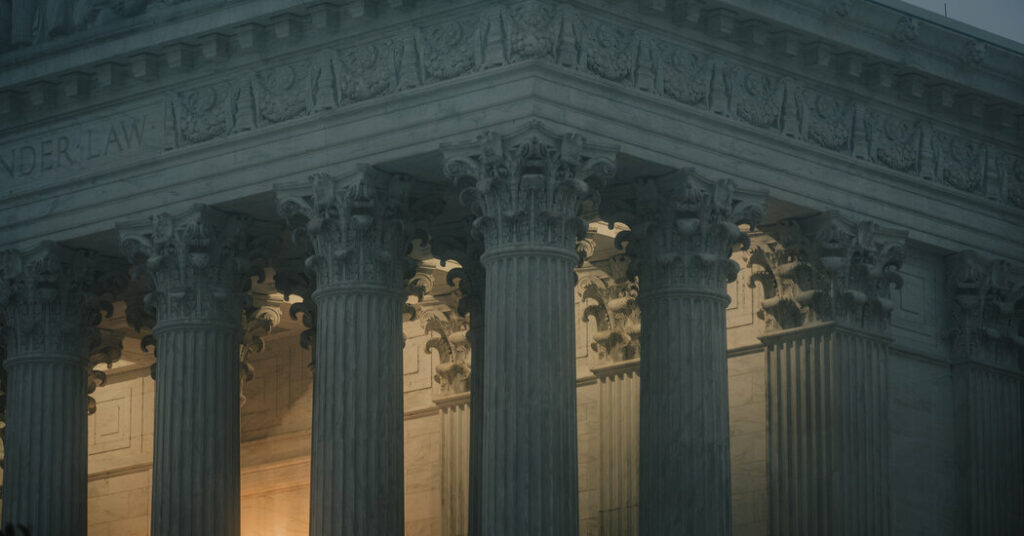Opinion | The Supreme Court’s Conservatives Control Even More Than You Realize
5 min read
Add this to the ways in which the Supreme Court is increasingly resembling just another political institution: Only one side of the ideological divide has the power to set the institution’s agenda.
This is a little-recognized, but highly significant, feature of the current 6-3 alignment of justices. Under longstanding tradition, it takes four votes to put a case on the court’s docket, the so-called rule of four. Not five, mind you, not a majority. But it does take four. And the Democratic appointees now seem to find themselves one vote short in case after case.
Why does this matter? Because the rule of law requires the court to do more than simply adhere to precedent when deciding cases. It also requires the court to reprimand lower courts when they refuse to follow Supreme Court decisions. If it doesn’t, those rulings are in danger of becoming dead letters, precedents that lose their force without being overruled.
Since the 1980s, the court has had almost entirely discretionary jurisdiction. It virtually never has to hear cases. It is almost always a choice whether to allow a lower federal court or a state supreme court to have the last word regarding a dispute. The court need not give reasons for granting or denying review or even disclose its vote tallies on whether to do so.
But for the past couple of generations, the rule of four appears to have worked quite well. Even though the court has consistently had a conservative majority, there has also been a steady band of four of the nine justices who could force cases — and, in doing so, issues — onto the docket. Sometimes the issues were big. Think, perhaps, of the case of Obergefell v. Hodges and the right of same-sex couples to marry. More often, the cases were relatively low-profile — lower court decisions refusing, for example, to apply civil rights protections that are already established.
Either way, the outnumbered liberal wing of the court had enough votes to require the court to expend its resources to hear and decide cases. And here’s the thing: In many of those cases, the court ultimately reversed by an overwhelming vote. The lower court decisions were indefensible.
But for the court to reverse a lower court decision refusing to honor a civil liberty, the case first has to be put on its docket. And that seems no longer to be happening in cases involving established rights favored by the liberal wing of the court.
Take two striking examples of cases that the court recently refused to set for argument in the term beginning in October.
In Brown v. Louisiana, the court allowed a conviction in a capital case to stand against the petitioner, David Brown, even though he provided evidence that the prosecution suppressed an accomplice’s statement corroborating Mr. Brown’s claim that he was only a minor participant in the crime. (I was one of the lawyers representing Mr. Brown.) Seven years before, the Supreme Court had chastised the Louisiana courts for allowing exactly this kind of unconstitutional gamesmanship. But now, faced with open defiance of its previous ruling, the court could muster only three of the four votes necessary to grant review. All that Justice Ketanji Brown Jackson could do, in a dissent joined by Justices Sonia Sotomayor and Elena Kagan, was warn that the court’s decision not to accept the appeal “should in no way be construed as an endorsement of the lower court’s legal reasoning.”
In another instance, the court was unwilling to take up a case from Mississippi involving a claim that prosecutors precluded potential jurors from serving on the basis of their race. Four years ago, the court had issued a sharp rebuke of this discriminatory practice. Yet last month, faced with another clear record from the very same state of such unconstitutional discrimination, the court again found itself with only its three Democratic appointees willing to hear the case in the coming term. The court, Justice Sotomayor bemoaned in a dissent joined by Justices Jackson and Kagan, was unwilling to take even a “modest step to preserve the force of its own recent precedent.”
One might argue that the inability of the Democratic appointees alone to put cases on the court’s docket is no great cause for concern. When a Republican is in the White House, the Democrats lack any agenda-setting power in the executive branch. And vice versa when a Democrat is in office. When Congress is in the hands of one political party or the other, the minority party is generally sidelined as well.
But in those situations, an election is never more than a few years away. If the public wants a president or Congress to turn its attention to different matters, it can vote new officials into office.
Not so with the Supreme Court. We might have the current 6-3 alignment for the next decade, maybe longer. Are we never to have cases during this time in which the court reverses lower courts for failing to follow past progressive decisions?
There is certainly room on the court’s docket for cases like these. In the term that just ended, the court heard and decided only 60 cases — more than a dozen fewer than the average over recent years.
In fact, if the court continues to block the Democratic appointees’ attempts to put cases on the court’s docket, Congress could even consider intervening. The rule of four is not etched in the Constitution or even in any legal rule or regulation. It is simply a matter of unwritten tradition. Congress, which has the power to regulate the court’s jurisdiction and procedures, could say only three votes are necessary to hear a case.
How people choose to spend their time is an expression of their values. So too with the Supreme Court. It’s time to pay more attention to which cases the court puts on its docket, not just how the court decides the cases it hears.
Jeffrey L. Fisher is a professor at Stanford Law School, where he co-directs the Supreme Court Litigation Clinic.
The Times is committed to publishing a diversity of letters to the editor. We’d like to hear what you think about this or any of our articles. Here are some tips. And here’s our email: [email protected].
Follow The New York Times Opinion section on Facebook, Twitter (@NYTopinion) and Instagram.
Source: Read Full Article






